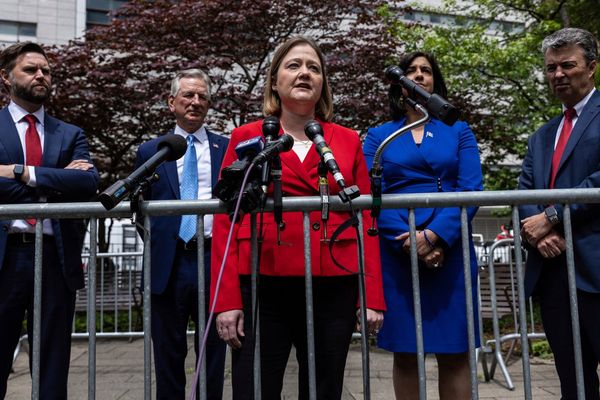/https://static.texastribune.org/media/files/128ec748956e1392ee9dcfb34e8fcd25/0109%20TT%20Event%20Glenn%20Hegar%2003%20TT.jpg)
Texas is projected to have $194.6 billion available in general revenue to fund the business of the state over the 2026-2027 biennium, a slight decrease from the last budget cycle while still putting Texas in a strong financial position, Texas Comptroller Glenn Hegar said Monday in his biennial revenue estimate to state lawmakers and leaders.
The estimate comes one day before the Texas Legislature convenes on Tuesday for the start of the 2025 legislative session. The only thing lawmakers are constitutionally required to do during the 140-day session ending on June 2 is pass a balanced budget, one that spends no more than what is estimated to be available.
[Watch a conversation with Comptroller Glenn Hegar]
Texas’ economic output will be below the state’s average but will continue to outpace the growth in the country overall, Hegar predicts.
“Texas’ economy doesn’t forecast a recession. We just don’t think it’ll grow in the next year or two at the same pace,” Hegar said during a Monday conversation with Texas Tribune editor-in-chief Matthew Watkins, adding that the state is “in a good position” compared to other states dealing with deficits.
This year’s estimate reflects a 1.1% drop from the amount of funds available during the 2024-25 biennium, when lawmakers were flush with a “once-in-a-lifetime” cash balance, Hegar said. The drop is attributable to a smaller beginning balance compared to the previous budget cycle, not a drop in state revenue. Tax collections are projected to rise, and for the first time, the state’s Economic Stabilization Fund — also known as the rainy day fund — is expected to exceed its constitutional cap. As a result, lawmakers have more money than is typical for general purpose spending.
Still, Hegar said lawmakers should make thoughtful financial decisions that focus on improving Texans’ lives.
“Despite positive economic numbers, many of our residents continue to feel the higher cost of groceries, housing and other necessities. And the lingering impacts of persistently rising prices mean many are struggling to ensure a bright future for their children,” Hegar said in a Monday statement accompanying the budget estimate.
The estimate includes an anticipated $176.4 billion in new revenue, most of which comes from sales and energy tax collections and can only be spent in the upcoming budget cycle. Sales tax collections are projected to increase by 9% from the previous two-year period, reaching $94.2 billion the next two years.
The estimated funds includes $23.8 billion expected to be leftover from the 2024-25 biennium when lawmakers cut property taxes and made several one-time investments, including in water and broadband infrastructure, that do not have to be funded again in the next budget.
Part of those leftover dollars include $4.5 billion that were earmarked for public education and education savings accounts but were not used because lawmakers failed to reach a compromise to enact a voucher-like program.
This year, lawmakers are expected to prioritize passing a school voucher program that uses taxpayer dollars to help pay for students’ private schooling. Lt. Gov. Dan Patrick, who presides over the Texas Senate, has called on Gov. Greg Abbott to declare private school vouchers an emergency item to give lawmakers a jumpstart on pushing the bill through the Legislature. Lawmakers cannot pass any bills within the first 60 days of the session unless it has been labeled an emergency item by the governor.
Monday’s estimate could change as economic forecasters receive new information. Weather-related disasters, the wars in Ukraine and the Middle East, China’s economic activities, and changes in federal policy could all cause economic disruption, Hegar said.
State revenue from all sources and for all purposes is expected to reach $362.2 billion. Part of that includes $115 billion the state is expected to collect in federal funds which goes toward dedicated purposes such as Medicaid and other federal programs including disaster assistance. The state will also collect about $70.7 billion in other fees, also reserved for specific purposes.
Competing priorities
A bevy of state leaders and advocates responded to Hegar’s estimates by urging lawmakers to use the extra cash to invest in their top priorities — ranging from cutting property taxes to investing in special education.
“With this surplus, my first focus is to continue to cut property taxes and increase teacher salaries,” Patrick said in a statement. The lieutenant governor said he’d also focus on one-time investments, such as adding new dispatchable power to the grid.
Texas House Democratic Caucus Chair Gene Wu, D-Houston, said the state should use the funds to invest in schools and health care, as well as water and power infrastructure.
“While these revenue projections echo 2023’s ‘once-in-a-lifetime’ cash balance, this time we must deliver different results,” Wu said in a statement. “We cannot afford another session where Republicans sell out to voucher scammers while our neighborhood schools struggle.”
After making gains at the ballot box in November, lawmakers who support private school vouchers have better odds than ever of passing their priorities. If the Legislature approves a school voucher bill, Hegar’s office would likely be responsible for administering the program, a task he said his office is up to fulfilling.
But when considering school vouchers, lawmakers should make sure they give the administering agency ample control to determine the best way to run the program, Hegar said, explaining that he would not want a piece of legislation to prescribe a particular vendor to use.
“I need to have options,” Hegar said during the Tribune event.
Does the rainy day fund need a cap?
Lawmakers established the rainy day fund in the 1980s during an oil bust to help the state during economic downturns. Taxes from crude oil and natural gas production are a large source of dollars for the fund.
And due to the growth of Texas’ oil and gas industry, the fund has ballooned in recent years and is projected to exceed its constitutional limit, according to Hegar’s budget estimate. The Texas Constitution limits the fund’s maximum balance using a formula based on how much general revenue was deposited into the fund during the previous biennium.
Dollars that exceed that maximum limit go into the general treasury to be used by lawmakers. With three-fifths of them approving, lawmakers can also tap the rainy day fund and have done so to fund measures such as water projects, disaster relief, public education and other projects.
“By 2035, if the cap continues to be in place and we keep adding more money and they don’t take money out… it’ll probably grow to be about $40 billion,” Hegar said. “If we remove the cap, that fund would grow to $80 billion.”
Without any legislative appropriations, the rainy day fund will reach a record $28.5 billion at the end of fiscal year 2027, Hegar estimates.
Hegar said he mentions the growth of the rainy day fund to allow lawmakers to consider eliminating the cap which would require a constitutional amendment. Removing the cap would allow the fund to grow significantly larger through the fund's investment earnings and could offer a benefit in the future during the next economic recession.
“Nobody knows when it will be or how deep it will be,” Hegar said. “But when you have that reserve, you have the ability to tap into it… to continue to provide services that people would expect, be it roads, water infrastructure, whatever it may be.”







